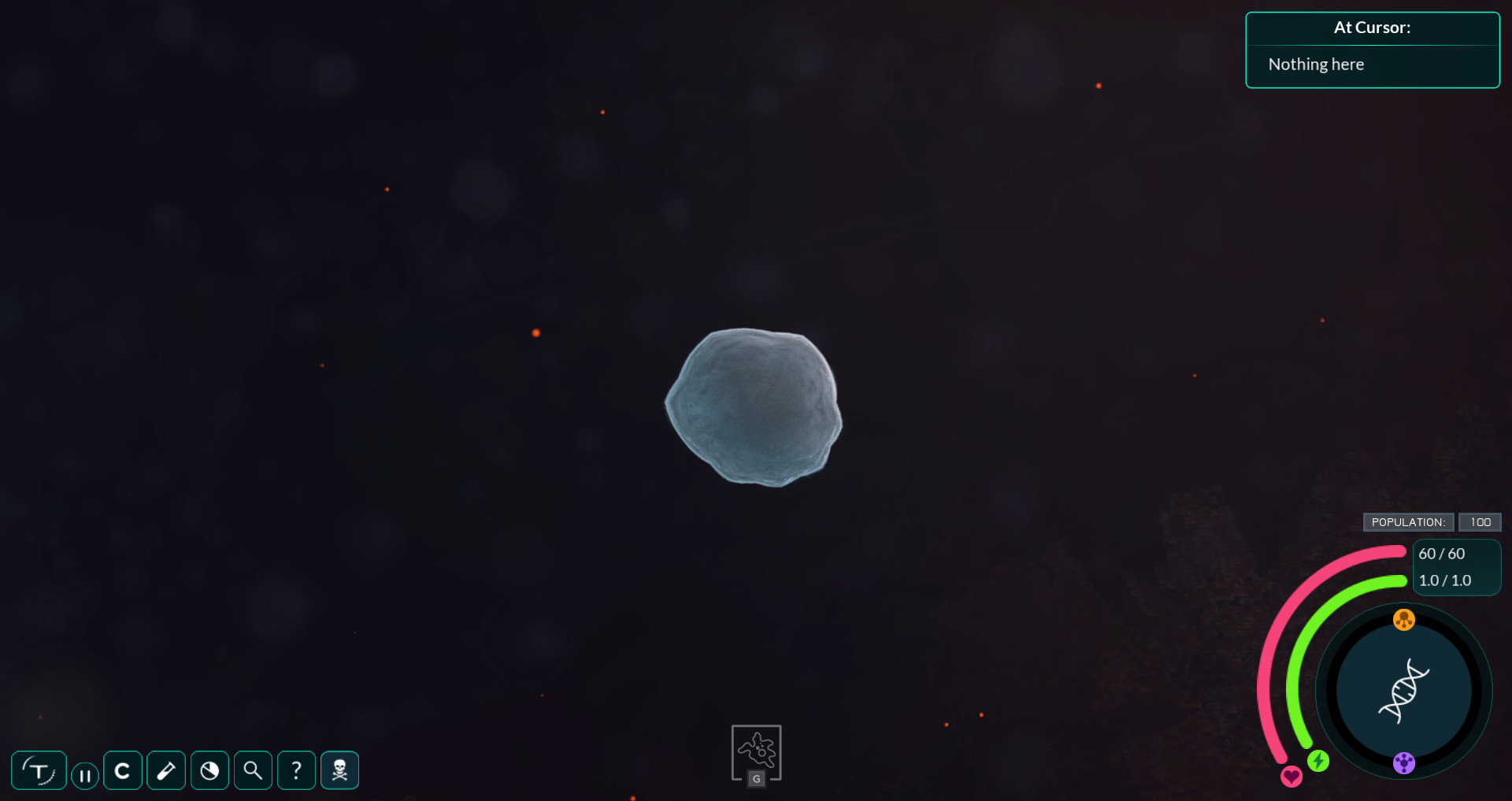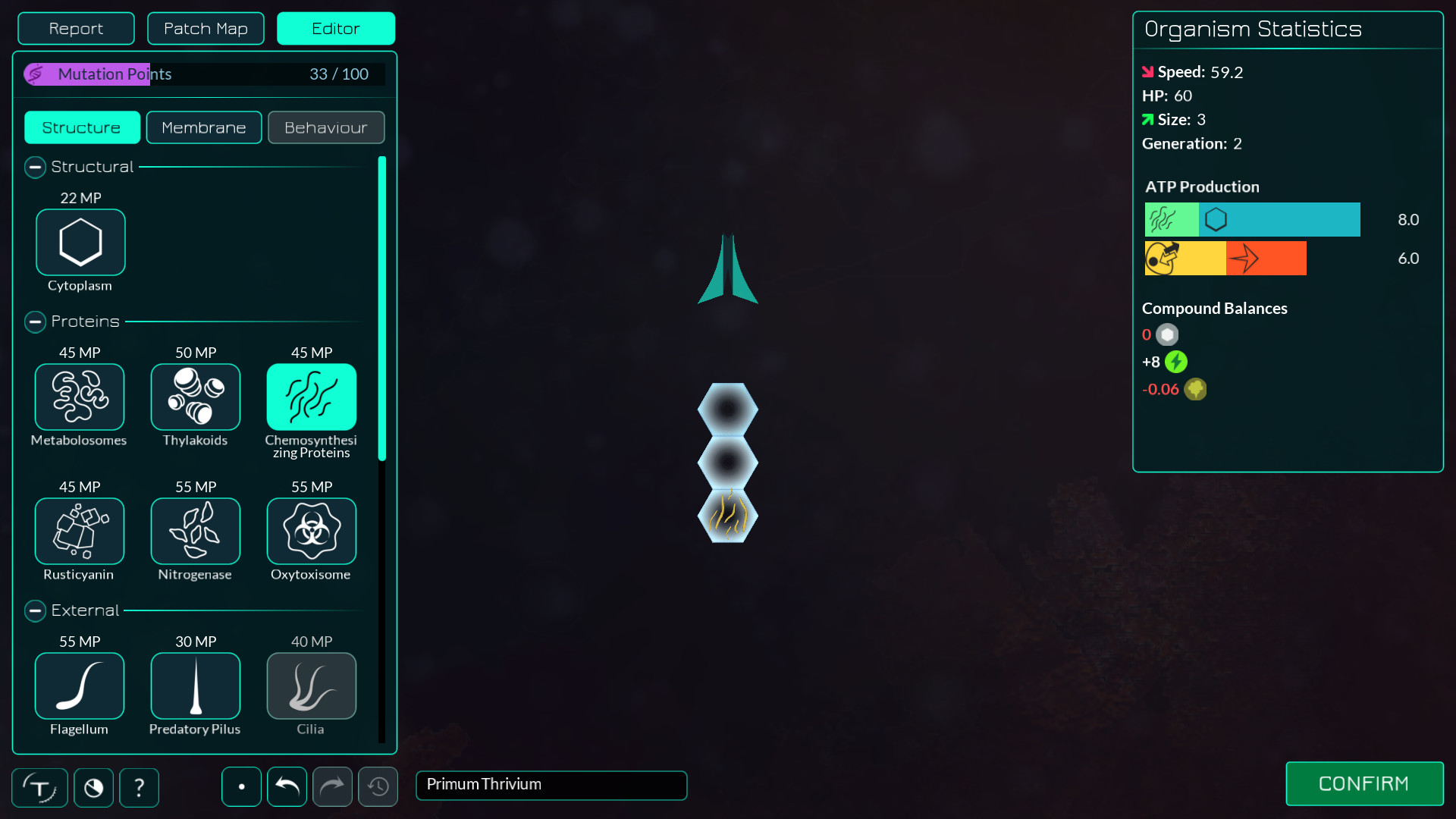In the Microbe Stage, you control a single microbe or a colony of microbes bound together. You swim through a watery environment to find the resources your cell needs to stay alive and to reproduce. Once you have reproduced, you enter the editor, where you can review how well your species and others are surviving, move to new biomes, and modify your species. Add new organelles, change your membrane, and change your cell's visuals. Your goal is to become a more complex lifeform by first evolving the nucleus to become a eukaryote, then using binding agents to form cell colonies, the precursor to the first multicellular lifeforms.
Current key features:
- Control an individual member of your species and survive the environment
- Predate on other species, use photosynsthesis or scavenge for resources
- Edit your species to make it more successful
- Compete with other species emerging on your planet via an evolution simulation
- Explore different biomes
- Fight other cells with multiple cellular level weapons
- Try different gameplay styles by specializing in different energy sources in subsequent playthroughs
- Learn about biology by using real compounds, organelles or parts inspired by real science
- Spread your species via the biome map
- Review and plan future actions by looking at population simulation results and graphs
- Learn the basics of the game with a light interactive tutorial
The major goals of Thrive are to create engaging, compelling gameplay that respects our players’ intelligence, and remain as accurate as possible in our depiction of known scientific theory without compromising the former. Thrive is an open-source project, and anyone with game development skill is welcome to join our team. The game uses the open-source Godot engine with the C# programming language.
If you don't have game development skills, you are still welcome to join our fan community. We would love to have you along for the long ride!
For five entire months straight our developers have worked and toiled to bring about a massive rework in the functionality of Thrives background processes. A massive undertaking that has left nothing untouched, and everything entirely different. This is without a doubt a fundamental change in the underlying rules of reality in the world of Thrive; A brand new physics engine complete with better performance. Nothing will quite feel the same as it once did, but its still Thrive, and it can only get better.
In focusing on this grand refactoring, we regrettably have little to show on the gameplay side of things, but it will be smoother sailing from here on out.

Our developers have worked hard to bring you an expanded Thrive experience. Weve outlined the major changes in this devblog, but you can see the patch notes at the end for a full list of features and bug fixes.
Performance Like Never Before

Having gone through a massive refactor behind the scenes, Thrive now runs at a greater speed than ever before. framerates will be higher, autoevo will be faster, and you may just be able to increase that entity cap in your settings. But thats not all that has changed behind the scenes! The physics calculations of Thrive have been entirely reworked.
Players might notice a tangible sense of weight during gameplay now; Large heavy cells are able to easily bat aside small chunks and bacteria as they make their way through. Cells have an average density that determines how quickly they can turn, and how fast they are able to move. You can even drift a little as you decelerate instead of coming to a complete stop on command. And even the generation of hitboxes is entirely different now, with the hitbox being determined by the shape of the cells membrane rather than its internal parts.

These changes are huge, and while they may not bring anything substantially noticeable to the realm of gameplay, they lay a vital foundation for the future of Thrive going forward.
A Guide To Thrive
The Thriveopedia is ever closer to becoming as we originally envisioned; Now performing its role as a guide for players to consult during gameplay to achieve a greater understanding of the parts they have at their disposal. Now included in the latest release is comprehensive information relating to each part available in the microbe stage.

Each page will be filled out with everything a player could ever want to know about a part. Its general stats, its processes, the customization options available to it, strategies on its use, and even information on how the part functions in real life!

Regrettably, not all of the organelle pages are fully filled out as of this release. So please look forward to more information becoming available to the Thriveopedia in each subsequent update!
New Part Customization
While they may be small, 0.6.4 does still bring some brand new features to the table. Players can now diversify their equipment with the brand new injectisome pilus mod, which exchanges some of its raw physical damage for toxic damage. This allows its user to bypass physical defenses with the pilus.

In addition, the vacuole has received a modification menu that allows players to specialize them for specific compounds. This greatly increases their overall storage value, but only for one compound.

Not to be left out of the fun, the chemoreceptor also has new customization options, with the ability to directly track nearby cells and not just loose compounds.
Other Notable Changes
- Added two new context specific microbe tracks that can play instead of the normal microbe ambiance when in those specific patch types.
- Fixed two very common multicellular crashes: InvalidOperationException: Sequence contains no matching element and ArgumentException: OrganelleTemplate cant be placed at this location.
- When low performance is detected in the menu the game will now prompt the player to disable the 3D menu backgrounds.
- Improved the visuals of the organism statistics panel and added / updated related tooltip icons as well.
- Multicellular colonies now use absolute positioning of members set by the editor. This isnt perfect (leaves gaps) but the problem with cells growing at the wrong positions randomly should be gone now.
- Membrane data generation now happens in a background thread to reduce stuttering happening while cells spawn.
- The AI will now avoid engulfing something it cannot digest, though they may still try occasionally. Depends on behavior values.
- Theres now a tutorial for the become multicellular button as many players seemed to not realize it was a button.
Full patch notes are at the end of this post.
Looking Ahead
With the massive rework to Thrives underlying systems, much of our focus is going to be centered around fixing any and all emergent bugs as we can. Most importantly of all, recent updates to Godot 4 has made porting Thrive to this newest version more of a possibility, which may potentially take precedence in the near future.
Want to hear more? Come join us in our upcoming developer Thrivestream to ask us whatever you like, and celebrate the new release:
You can also share your thoughts and feelings on these latest changes on our community feedback thread .
Patch Notes
- Refactored the entire microbe gameplay code to use an Entity Component System (ECS) architecture and a different physics engine (Jolt). This took up the vast majority of the time spent on this release. As a result of this many things in the game will feel slightly different and there will definitely be new bugs that have slipped past us. We will attempt to quickly fix any new bugs introduced with this change.
- The game performance is now 20-100% better than before thanks to the ECS and physics rework (different benchmark parts have different improvements, and different gameplay conditions also have different performance gains)
- Improved auto-evo performance by about 50%
- Added a native C++ library for Thrive that has the physics engine integration for now but we can in the future move computation heavy parts of the game there that might benefit performance
- Added two new context specific microbe tracks that can play instead of the normal microbe ambiance when in those specific patch types
- Added Thriveopedia pages for each of the organelles currently in the game
- Fixed 2 very often reported multicellular crashes: InvalidOperationException: Sequence contains no matching element and ArgumentException: OrganelleTemplate can't be placed at this location
- When low performance is detected in the menu the game will now prompt the player to disable the 3D menu backgrounds
- Improved the visuals of the organism statistics panel and added / updated related tooltip icons as well
- Chemoreceptor can now be upgraded to detect cells of a certain species
- Added vacuole upgrade to specialize it for a certain compound. Specialized vacuole stores double the normal amount of the specialized compound but provides no storage for other compounds.
- The pilus now applies damage based on the physics penetration amount instead of always a fixed value. Faster collisions result now in more physical damage.
- The pilus can now be upgraded to an injectisome to switch the damage to be toxic (instead of physical) and also to apply the full damage no matter how light the hit is
- Microbes now use the physics engine to turn which should result in reduced rotation related bugs or slight issues
- Microbe physics shapes are now a single convex body which performs better and it much more closely matches the visual size of the membrane
- Microbe colony physics shape is now a single combined body. This should fix rare bugs with pili detaching or toxins hitting self when firing them.
- Multicellular colonies now use absolute positioning of members set by the editor. This isn't perfect (leaves gaps) but the problem with cells growing at the wrong positions randomly should be gone now.
- Membrane data generation now happens in a background thread to reduce stuttering happening while cells spawn
- Added a tutorial for negative ATP balance
- The AI will now most of the time not try to engulf something it cannot digest
- The AI will now remember what it was doing before a save thanks to the component data being easier to load fully intact
- Added 3D panorama backgrounds for various patch types for the late multicellular underwater part. These were completed a while ago but were never accessible in game until now.
- There's now a basic page name search in the Thriveopedia
- Improved initial compound handling for multicellular colonies
- There's now a tutorial for the become multicellular button as many players seemed to not realize it was a button
- Duplicating a cell type now selects it in the early multicellular editor
- Becoming multicellular now has a timeline entry for permanent record when it happened
- Added early multicellular freebuild mode
- Organelle chunks that are dropped now stop playing animations (for example flagellum swim animation)
- Fixed the most often reported crash, which was likely due to Godot integration with Bullet physics, by switching physics engines
- Fixed subshape out of range errors from physics also thanks to entirely redoing the gameplay physics
- Fixed the osmoregulation editor tooltips not updating based on the difficulty and current membrane
- Fixed the AI shooting too early at a target it wasn't pointing at yet due to rotation no longer being almost instant
- Fixed bug with glucose reduction showing up sometimes as NaN
- Fixed the global timeline not showing populations correctly
- Fixed a bug with incorrect resulting MP in early multicellular from incorrectly calculated actions on separate cell types
- Fixed saving bug with ObjectDisposedException with HostileEngulfer
- Fixed an exploit with deleting and duplicating cell types giving infinite MP
- Fixed a crash when double clicking on organelle move
- Fixed organelle popup menu not being tall enough with certain languages selected
- Fixed symmetry trying to place multiple unique organelles
- Fixed a crash when loading a save while load was already in progress (the new load is now prevented until the previous save/load operation completes)
- Fixed the auto-evo exploring tool map not panning to show the selected patch initially
- Fixed keyboard navigation in input options
- Added one more fix (the 4th) now against accidental cannibalism (when turning multicellular)
- Added multithreading to microbe growth, made easier thanks to the ECS architecture
- Improved externally positioned organelles to use much less CPU time
- Various disposed object exceptions should no longer be possible to happen with the gameplay no longer using Godot Nodes to implement it
- Player cell related change callbacks now use invoke to trigger to reduce the chance of a rare bug triggering with them
- Failure to delete a save should now give a popup warning about the error
- Art gallery slideshow now works for models as well as images
- Added a new separate icon for oxytoxisome to no longer use the toxin vacuole icon
- Added a new icon for osmoregulation
- Photostudio is now slightly faster at creating images of cells
- Switched the early multicellular editor to use images of cells instead of cell objects for showing the body plan. This improves the performance a ton when there were large body plans being edited.
- Tweaked the colour of the editor confirm button warning badge to make it more consistent with the other GUI
- Fixed some situations where the editor confirm button warning got stuck on
- Added new cheat in the microbe cheat menu to control the current time of day
- Improved the handling of creating organelle upgrade actions / changes in the editor
- The GUI no longer grabs focus during intro video to reduce chance of accidentally interacting with the menu while the video is playing
- Fixed art gallery filter categories not reacting to language change
- Species colour not applying to all organelles problem should now be fixed due to the component architecture where all organelles should read the consistent colour values that are copied
- Organelle graphics are now slightly more colourful and pop out against the membrane more
- Some microbe colony related corner cases are no longer relevant, but there's undoubtedly new bugs still left to fix with the newly redone system
- Steam: fixed username display not reacting to language change
- Steam: fixed bug with displaying library licenses
- Split microbe HUD to its own scene to have better organization of the microbe stage
- Moved enzyme descriptions to our JSON files to no longer have hardcoded descriptions in the code per enzyme type
- Improved internal organelle position code to use read only data references when the data should not be modified. Same improvement was also made to some simulation parmeters data that was also returned as modifiable objects.
- Git submodule info (current commits) is now included when packaging the game
- Created a system to distribute precompiled native libraries for Thrive to more easily setup the new version for partial development
- Updated code checking tools version
- Updated YamlDotNet from 13.1.1 to 13.7.1
- Updated Microsoft.CodeAnalysis.CSharp from 4.6.0 to 4.7.0
- Updated AngleSharp from 1.0.6 to 1.0.7
- Added new languages: Bengalian, Belarussian, and Macedonian
- Updated translations
Minimum Setup
- OS: Ubuntu 20.04 or latest Fedora version
- Processor: AMD Ryzen 3 3300UMemory: 4 GB RAM
- Memory: 4 GB RAM
- Graphics: Intel HD Graphics 530
- Storage: 1 GB available space
Recommended Setup
- OS: Ubuntu 20.04 or latest Fedora version
- Processor: AMD Ryzen 5 2600X or Intel equivalentMemory: 8 GB RAM
- Graphics: GeForce GTX 970 or AMD equivalent
- Storage: 5 GB available space
[ 6338 ]
[ 5853 ]
[ 1933 ]
[ 2282 ]













































